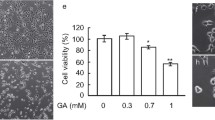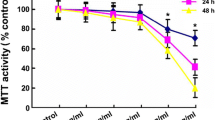Abstract
The Maillard reaction that leads to the formation of advanced glycation end products (AGE) is considered to play an important role in the pathogenesis of Alzheimer’s disease (AD). Until now AGE derived from glucose (glucose-AGE) have been mainly investigated, so we established new AGE species derived from α-hydroxyaldehydes and dicarbonyl compounds. We have found that AGE derived from glyceraldehyde (glycer-AGE) and glycolaldehyde (glycol-AGE) showed strong neurotoxicity for primary cultured rat cortical neurons in vitro. In this study, we immunohistochemically examined the localization of glycer-AGE and glycol-AGE in the brains of AD patients and elderly controls. Most of the neurons in AD or control brains did not show any immunoreaction with glycol-AGE. In AD brains, glycer-AGE was mainly present in the cytosol of neuron in the hippocampus and para-hippocampal gyrus, but not in senile plaques and astrocytes. The pattern of immunopositivity was uniform and powdery, not dot-like. The distribution of glycer-AGE differed from that of glucose-AGE, which was detected at both intracellular and extracellular sites. This suggests that glycer-AGE has a pathological role different from glucose-AGE in AD. In the central nervous system, glyceraldehyde is generated via the glycolytic pathway from glyceraldehyde-3-phosphate by glyceraldehyde-3-phosphate dehydrogenase (GAPDH). We hypothesize that perikaryal glycer-AGE immunopositivity of neurons reflects an increase of cytoplasmic glycer-AGE along with the decline of GAPDH activity.



Similar content being viewed by others
References
Bigl M, Bruckner MK, Arendt T, Bigl V, Eschrich K (1999) Activities of key glycolytic enzymes in the brains of patients with Alzheimer’s disease. J Neural Transm 106:499–511
Brownlee M, Vlassara H, Cerami A (1984) Nonenzymatic glycosylation and the pathogenesis of diabetic complications. Ann Intern Med 101:527–537
Crter J, Lippa CF (2001) Beta-amyloid, neuronal death and Alzheimer’s disease. Curr Mol Med 6:733–737
Finch CE, Cohen DM (1997) Aging, metabolism, and Alzheimer disease: review and hypotheses. Exp Neurol 143:82–102
Glomb MA, Monnier VM (1995) Mechanism of protein modification by glyoxal and glycoaldehyde, reactive intermediates of the Maillard reaction. J Biol Chem 270:10017–10026
Ishitani R (1997) A roll for GAPDH in neuronal apoptosis. Seikagaku 69:1107–1111
Ledl F, Schleicher E (1990) New aspects of the Maillard reaction in foods and in the human body. Angew Chem Int Ed Engl 6:565–706
Li JJ, Surini M, Catsicas S, Kawashima E, Bouras C (1995) Age-dependent accumulation of advanced glycosylation end products in human neurons. Neurobiol Aging 16:69–76
Mazzola JL, Sirover MA (2001) Reduction of glyceraldehydes-3-phosphate dehydrogenase activity in Alzheimer’s disease and in Huntington’s disease fibroblasts. J Neurochem 76:442–449
Mazzola JL, Sirover MA (2003) Subcellular alteration of glyceraldehyde-3-phosphate dehydrogenase in Alzheimer’s disease fibroblasts. J Neurosci Res 71:279–285
Meguro K, LeMestric C, Landeau B, Desgranges B, Eustache F, Baron JC (2001) Relations between hypometabolism in the posterior association neocortex and hippocampal atrophy in Alzheimer’s disease: a PET/MRI correlative study. J Neurol Neurosurg Psychiatry 71:315–321
Monnier V, Cerami A (1981) Nonenzymatic browning in vivo: possible process for aging of long-lived proteins. Science 211:491–493
Namiki M (1988) Chemistry of Maillard reactions: recent studies on the browning reaction mechanism and the development of antioxidants and mutagens. Adv Food Res 32:115–184
Sasaki N, Fukatsu R, Tsuzuki K, Hayashi Y, Yoshida T, Fujii N, Koike T, Wakayama I, Yanagihara R, Garruto R, Amano N, Makita Z (1998) Advanced glycation end products in Alzheimer’s disease and other neurodegenerative diseases. Am J Pathol 153:1149–1155
Sasaki N, Toki S, Choei H, Saito T, Nakano N, Hayashi Y, Takeuchi M, Makita Z (2001) Immunohistochemical distribution of the receptor for advanced glycation end products in neurons and astrocytes in Alzheimer’s disease. Brain Res 888:256–262
Sirover MA (1997) Role of the glycolytic protein, glyceraldehyde-3-phosphate dehydrogenase, in normal cell function and in cell pathology. J Cell Biochem 66:133–140
Smith MA, Taneda S, Richey PL, Miyata S, Yan SD, Stern D, Sayre LM, Monnier VM, Perry G (1994) Advanced Maillard reaction end products are associated with Alzheimer’s disease pathology. Proc Natl Acad Sci USA 91:5710–5714
Takeuchi M, Makita Z, Yanagisawa K, Kameda Y, Koike T (1999) Detection of noncarboxymethyllysine and carboxymethyllysine advanced glycation end products (AGE) in serum of diabetic patients. Mol Med 5:393–405
Takeuchi M, Bucala R, Suzuki T, Ohkubo T, Yamazaki M, Koike T, Kameda Y, Makita Z (2000) Neurotoxicity of advanced glycation end-products for cultured cortical neurons. J Neuropathol Exp Neurol 59:1094–1105
Takeuchi M, Makita Z, Bucara R, Suzuki T, Koike T, Kameda Y (2000) Immunological evidence that non-carboxymethyllysine advanced glycation end-products are produced from short-chain sugars and dicarbonyl compounds in vivo. Mol Med 6:114–115
Usui T, Shizuuchi S, Watanabe H, Hayase F (2004) Cytotoxicity and oxidative stress induced by the glyceraldehyde-related Maillard reaction products for HL-60 cells. Biosci Biotechnol Biochem 68:333–340
Wong A, Luth HJ, Deuther-Conrad W, Dukic-Stefanovic S, Gasic-Milenkovic J, Arendt T, Munch G (2001) Advanced glycation endproducts co-localize with inducible nitric oxide synthase in Alzheimer’s disease. Brain Res 920:32–40
Author information
Authors and Affiliations
Corresponding author
Rights and permissions
About this article
Cite this article
Choei, H., Sasaki, N., Takeuchi, M. et al. Glyceraldehyde-derived advanced glycation end products in Alzheimer’s disease. Acta Neuropathol 108, 189–193 (2004). https://doi.org/10.1007/s00401-004-0871-x
Received:
Revised:
Accepted:
Published:
Issue Date:
DOI: https://doi.org/10.1007/s00401-004-0871-x




